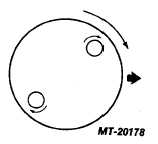|
| |
TRUCK SERVICE MANUAL
TM 5-4210-230-14&P-1
on floor jacks. Brake drag is checked by "feel", rotating the
drum in the direction of forward rotation as adjustment is
made.
Be sure the wheel bearings are properly adjusted (refer to
WHEELS, RIMS, TIRES Section, CTS-2032) and with brake
drums cool.
Adjust each shoe in turn by rotating adjuster cam stud
and drum in forward direction of drum rotation until a light
drag is noticeable (Fig. 4). Do not apply excessive force on
stud -13.6 Nm (120 in. lbs.) maximum. Back off adjuster
stud slightly (approximately 6 to 12 degrees). Drum should
turn freely.
Repeat procedure on opposite cam stud.
Perform same operation on brake group on opposite side
of vehicle.
BRAKE SHOE REMOVAL
Refer to Fig. 1 for numbers in parenthesis.
1.
Position vehicle on floor stands so that the wheels
are free to turn.
2.
Remove wheel hub and drum assemblies.
3.
Secure pistons in wheel cylinders with cylinder
clamps.
4.
Remove brake shoe retracting springs.
5.
Remove each shoe hold-down "C" washer (12) and
washer (11).
6.
Pull shoes free from adjuster cams and then rotate
shoe from brake group freeing ends of wheel
cylinders.
If wheel cylinder connector tubes (21) are removed, mark
wheel cylinder ports to which tubes are attached to avoid error
in re-assembly. Difficulty will be encountered in bleeding
operation if tubes are assembled in wrong location.
Fig. 4 Brake Adjustment
CLEANING AND INSPECTION
Thoroughly clean all parts (except drums) free of dirt and
grease with cleaning solvent and wipe dry.
Because studies have indicated that exposure , to
excessive amounts of asbestos dust may be a potential health
hazard, OSHA has set maximum limits of levels of airborne
asbestos dust to which workers may be exposed. Since most
automotive friction materials normally contain a sizable
amount of asbestos, it is important that people who handle
brake linings be aware of the problem and know the
precautions to be taken.
OSHA standards should be consulted with respect to
mandatory requirements as well as for suggested procedures
to minimize exposure.
DRUMS, BRAKE SHOES AND LINING
For complete details pertaining to reconditioning drums
and shoes, refer to CTS-2779.
WHEEL CYLINDERS
Inspect wheel cylinders for signs of fluid leakage or
deteriorated rubber dust boots. If brake fluid is leaking out of
wheel cylinders, replace or recondition wheel cylinders.
Some brake groups have wheel cylinder piston stops and
the wheel cylinder must be removed for reconditioning.
The two wheel cylinders mounted on one brake are
identical; HOWEVER, CYLINDERS FOR LEFT OR RIGHT
HAND BRAKES HAVE OPPOSITE CASTINGS.
Clean mating surfaces of cylinders and backing plate
before assembly to insure proper alignment.
RETRACTING SPRINGS
Inspect retracting spring for distortion such as nicks,
twisted shanks or spread of coils. Damaged spring must be
replaced.
ADJUSTING CAM AND SHOE GUIDE STUDS
Adjustment cam and shoe guide studs are equipped with
friction springs. They should easily turn with a wrench, but
should not be loose. If frozen, lubricate with penetrating oil
and work free.
CTS-2078T - Page 4
PRINTED IN UNITED STATES OF AMERICA
|

